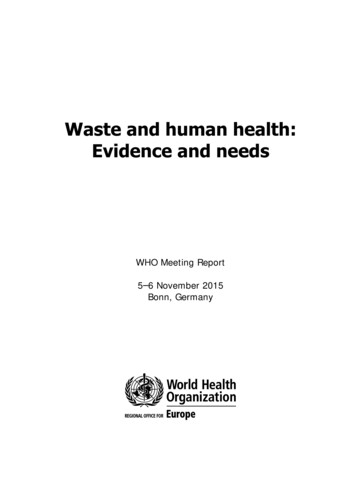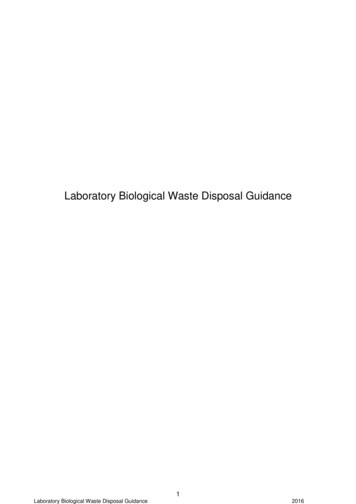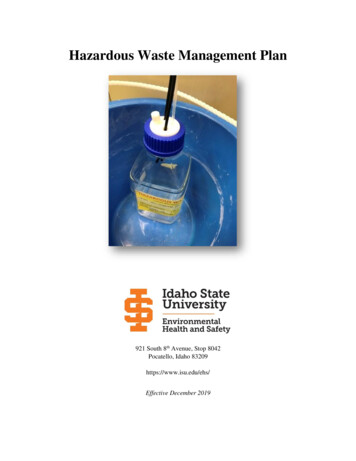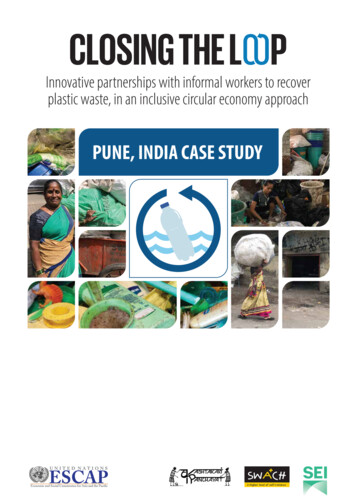
Transcription
Waste and human health:Evidence and needsWHO Meeting Report5–6 November 2015Bonn, Germany
AbstractManagement of waste is a demanding and challenging undertaking in all European countries, withimportant implications for human health and well-being, environmental preservation, sustainabilityand economy. Comprehensive legal frameworks, mainly developed on the basis of environmentalcriteria, exist that regulate waste management. Compliance with these regulations has resulted insignificant progress; however concerns remain as to the possible health impacts of waste circulation,management and disposal, especially in connection with informal practices and obsoletetechnologies. The available scientific evidence on the waste-related health effects is not conclusive,but suggests the possible occurrence of serious adverse effects, including mortality, cancer,reproductive health, and milder effects affecting well-being. This evidence, combined with thegrowing importance of sustainability considerations, should allow Member States of the WHORegional Office for Europe to formulate health-friendly policy orientations.KeywordsWASTE MANAGEMENT - methodsHAZARDOUS WASTE - adverse effectsENVIRONMENTAL HEALTHHEALTHEUROPEAddress requests about publications of the WHO Regional Office for Europe to:PublicationsWHO Regional Office for EuropeUN City, Marmorvej 51DK-2100 Copenhagen Ø, DenmarkAlternatively, complete an online request form for documentation, health information, or for permission to quote ortranslate, on the Regional Office web site (http://www.euro.who.int/pubrequest). World Health Organization 2016All rights reserved. The Regional Office for Europe of the World Health Organization welcomes requests forpermission to reproduce or translate its publications, in part or in full.The designations employed and the presentation of the material in this publication do not imply the expression ofany opinion whatsoever on the part of the World Health Organization concerning the legal status of any country,territory, city or area or of its authorities, or concerning the delimitation of its frontiers or boundaries. Dotted lineson maps represent approximate border lines for which there may not yet be full agreement.The mention of specific companies or of certain manufacturers’ products does not imply that they are endorsed orrecommended by the World Health Organization in preference to others of a similar nature that are not mentioned.Errors and omissions excepted, the names of proprietary products are distinguished by initial capital letters.All reasonable precautions have been taken by the World Health Organization to verify the information containedin this publication. However, the published material is being distributed without warranty of any kind, eitherexpress or implied. The responsibility for the interpretation and use of the material lies with the reader. In no eventshall the World Health Organization be liable for damages arising from its use. The views expressed by authors,editors, or expert groups do not necessarily represent the decisions or the stated policy of the World HealthOrganization.
CONTENTSAcknowledgements . 2Abbreviations . 3Introduction. 4Waste management in Europe: the framework for the production and management . 5EU legislation on waste . 5The Basel Convention and waste movements . 6Separate collection . 7Green growth. 8Circular economy . 8The informal sector . 9Production of waste . 9Waste management . 11Health effects of waste management . 14Population exposed to pollution from waste management . 14Municipal solid waste – landfills. 15Exposure assessment . 15Health effects . 15Municipal solid waste – incinerators . 16Exposure assessment . 16Health effects . 17Towards a European assessment of the health impact of landfilling . 18Hazardous and toxic waste . 19Emerging priorities: E-waste . 20Discussion points . 20Knowledge gaps . 21References . 23Annex 1 . 28Guidance documents and other support actions for implementation ofEU waste legislation. 28Waste Framework Directive (WFD) . 28Mining Waste . 28WEEE/RoHS . 28ELV Directive . 29The Waste Shipment Regulation . 29BREFs on best available techniques. 29More information on EU waste policy and legislation . 29Annex 2: Meeting programme . 30Annex 3: List of participants . 32
AcknowledgementsThis report reflects the discussion and conclusions of the WHO meeting Waste and humanhealth: evidence and needs, held in Bonn, Germany, on 5-6 November 2015. Programme andparticipants in the meeting are reported in the Annexes. WHO is most grateful to allparticipating experts who shared their knowledge, experiences and views.The report was compiled by the meeting rapporteur Andrea Ranzi, Regional EnvironmentalProtection Agency of Emilia-Romagna, Italy, on the basis of oral and written contributions fromparticipants. Maria Dunbar, University of Copenhagen, provided invaluable support to thedrafting and finalization.The meeting was chaired by Pietro Comba, National Health Institute of Italy.The meeting was financially supported by the German Federal Ministry for the Environment,Nature Conservation, Building and Nuclear Safety, whose contribution is gratefullyacknowledged.2
AbbreviationsACattributable casesAFexpattributable fraction in exposed peopleBATbest available techniqueDALYsdisability adjusted life yearsDWdisability weightECEuropean CommissionEEAEuropean Environment AgencyEHPEuropean Environment and Health ProcessEPRextended producer responsibilityEUEuropean UnionEU-15EU member countries until 30 April 2004EU-27EU member countries from 1 January 2007 until 30 June 2013EU-28EU member countries since 1 July 2013HIAhealth impact assessmentH2Shydrogen sulphideICIinstitutional, commercial and industrialLdisease durationMBTmechanical biological treatmentNGOnongovernmental organizationNIMBYnot in my backyardPAHpolycyclic aromatic hydrocarbonsPCBpolychlorinated biphenylPCDDpolychlorinated dibenzo-p-dioxinsPCDFpolychlorinated dibenzofuransPCTpolychlorinated terphenylPICprior informed consentPOPpersistent organic pollutantPPPpolluter pays principleRRrelative riskSDGSustainable Development GoalWEEEwaste electrical and electronic equipment3
IntroductionManagement of waste is a demanding and challenging undertaking in all European countries,with important implications for human health and well-being, environmental preservation,sustainability and economy. WHO and many other health agencies worldwide have addressedthe health implications of waste in the past (WHO Regional Office for Europe, 2007).Waste is part of the agenda of the European Environment and Health Process (EHP), initiated inthe late 1980s by European countries to eliminate the most significant environmental threats tohuman health. Progress has been marked by a series of ministerial conferences held every fiveyears and coordinated by WHO. The fifth and latest conference was held in Parma, Italy, in2010. The 53 Member States of the WHO European Region set clear-cut targets to reduce theadverse health impact of environmental threats in the next decade. As the process is heading toits Sixth Ministerial Conference on Environment and Health in 2017, Member States haveincluded waste among the topics to be addressed in the Conference.In order to support the EHP and prepare for 2017, the WHO Regional Office for Europe decidedto hold an expert consultation to review the evidence on the health effects of urban andhazardous waste and to explore practices, needs, knowledge gaps, and resources in MemberStates. The main areas of discussion were: current epidemiological evidence, relevant legal andnormative frameworks, feasibility of policy options and their economic implications. The expertmeeting was attended by 26 participants, from 10 countries and 5 International Organizations.This report presents the main findings of the exercise, which confirm that health impacts ofwaste disposal can be substantial. While modern technology for waste management candramatically reduce noxious emissions and human exposure to hazardous agents, many casespersist where old generation facilities are in use, or worse where informal uncontrolled disposalsuch as casual dumping or open-air burning of waste occurs, typically affecting marginalizedgroups. It appears urgent to address the most acute occurrence of waste-related humanexposure to toxic agents, and to accelerate the process of adoption of modern waste treatmenttechnology.Sustainability is also of growing prominence and there is increasing interest in furtherpromoting circular economy, in line with the European Union (EU) waste hierarchy, which givespriority to reduced production and re-use or recycling of waste over incineration and landfilling.The latter, in particular, has been phased out in several countries due to its environmentalimplications.On the basis of the available evidence on the health impacts of waste, further consultation willbe held with Member States in 2016 in order to identify priorities, goals and policy action thatcan reduce detrimental health effects and their inequality, improve human well-being andpromote long-term sustainability across Europe and beyond.The following summarises the main outcomes of the meeting.4
Waste management in Europe: the framework for theproduction and managementEU legislation on wasteThe EU legislation and policy on waste addresses negative implications for environment andhealth. EU waste legislation has been developed and continuously modernized since the 1970s.The Directive 2008/98/EC on waste, the so-called Waste Framework Directive, (Council of theEuropean Union and European Parliament, 2008) introduces the basic concepts and definitionsrelating to waste management, such as types of waste, recycling and recovery. It establisheswhen waste ceases to be waste and becomes a secondary raw material (so-called end-of-wastecriteria), and distinguishes between waste and by-products. The Directive lays down some basicwaste management principles: it requires that waste be managed without endangering humanhealth and harming the environment, in particular without risk to water, air, soil, plants oranimals, without causing a nuisance through noise or odours, and without adversely affectingthe landscape or places of special interest. Waste legislation and policy of the EU MemberStates is based on the waste management hierarchy seen below in Figure 1, prioritized fromtop to bottom:Figure 1. EU waste management hierarchyThe Directive provides for the polluter pays principle (PPP) and the extended producerresponsibility (EPR, a strategy promoting the integration of environmental costs associated withgoods throughout their life cycles into the market price of products). It also incorporatesprovisions on hazardous waste and waste oils (old directives on hazardous waste and waste oilswere repealed with effect from 12 December 2010), and includes two recycling and recoverytargets to be achieved by 2020: 50% preparing for re-use and recycling of certain waste materials from households andother origins similar to households; and70% preparing for re-use, recycling and other recovery of construction and demolitionwaste.The Directive requires that Member States develop and adopt waste management plans andwaste prevention programmes.5
Another piece of legislation which is of paramount importance is the Landfill Directive1999/31/EC (Council of the European Union, 1999). This Directive aims at significantly reducinglandfilling. Landfilling is the worst option from an environmental and resource efficiencyperspective. Since biodegradable waste is of a particular concern, the current Directive hastargets for diverting such wastes from landfills, which should be fully implemented by 2020.Where waste needs to be landfilled, it must be sent to landfills which comply with therequirements of the Landfill Directive. The objective is to prevent or reduce negative effects onthe environment as much as possible, in particular on surface water, groundwater, soil, air, andon human health by introducing stringent technical requirements for landfills.Standard procedures for the acceptance of waste in a landfill are prescribed to reduce risks,including that waste must be treated before being landfilled; hazardous waste must be placedin a hazardous waste landfill, and landfills for non-hazardous waste must be used for municipalwaste and for other non-hazardous waste. Certain categories of waste may not be accepted ina landfill, i.e. liquid waste; flammable waste; explosive or oxidising waste; hospital and otherinfectious clinical waste; used tyres (with certain exceptions); and any other type of wastewhich does not meet the acceptance criteria (Annex II of the Landfill Directive). The Directivealso sets up a system of operating permits for landfill sites.The Basel Convention and waste movementsAnother piece of legislation that is important in this context is the Waste Shipment Regulation(Regulation 1013/2006/EC) which implements the Basel Convention on the Control ofTransboundary Movements of Hazardous Wastes and Their Disposal, including the Basel BanAmendment regulating transboundary movements for reuse, recycling or recovery operations(Council of the European Union and European Parliament, 2006). Under the Regulation, certainwaste shipments are prohibited, including shipments of hazardous waste from the EU todeveloping countries. For other shipments, the regulation prescribes either a notificationprocedure (the “Prior Informed Consent (PIC) procedure”) or information requirements. Illegalwaste shipments have been identified as a serious problem existing at a significant scale.Through inspections in recent years at sea-ports, on roads and in companies, it has beendiscovered that around 25% of shipments containing waste in the EU do not comply with theWaste Shipment Regulation. Numerous reports by nongovernmental organizations (NGOs),media and studies have shown that large amounts of waste originating in the EU are illegallyexported to developing countries in Africa and Asia (EC, 2013). In order to improve MemberStates’ inspection systems, ensure proper controls and effectively prevent illegal shipments, theWaste Shipment Regulation was strengthened in May 2014 (Council of the European Union,2014). Member States will have to establish risk-based inspection plans and provide newpowers to national inspectors. These changes to the Regulation have to be applied by MemberStates in 2016/2017. The reinforced inspections should help to reduce illegal exports of waste.The European Commission (EC) is currently preparing the ground for an electronic dataexchange for waste shipment notifications and an implementing act on this topic is scheduledfor 2016/2017. The goal is to replace the current system of paper documents on wasteshipments with electronic exchange of relevant data. Today, some documents, such asnotification and movement documents, create a very large administrative burden andpaperwork between industry and the different authorities involved. The authorities in someMember States must handle more than 100 000 pages of waste shipment documents per year.6
Besides saving on paperwork, an efficient electronic system will improve transparency andbetter traceability of waste flows, including better control of illegal waste trafficking.EU directives also cover the environmentally sound management of certain waste streams,including: electrical and electronic equipment waste;packaging and packaging waste;batteries and accumulators;end-of-life vehicles;sewage sludge;mining waste; andpolychlorinated biphenyl (PCB) and polychlorinated terphenyl (PCT) waste (EC, 2016b).These directives share the same principle in terms of substance restrictions, extended producerresponsibility as well as collection, recovery and recycling targets. In addition to the abovementioned recycling and recovery targets for household waste and construction/demolitionwaste, a number of specific targets have been laid down for Member States to recycle specificwaste streams. The waste stream directives have been key in improving waste management,stimulating innovation and changing consumer behaviour.Separate collectionSeparate collection of waste will further help increase recycling yields and is among the mainfacilitating factors of increased recycling. Separate collection of paper, metal, plastic and glasshas been gaining popularity and has been obligatory since 2015 in several European countries.Institutional, Commercial and Industrial (ICI) waste is generally homogenous and thereforemore often separately collected than household waste. However, there is still room forimprovement in effectiveness and efficiency (Council of the European Union and EuropeanParliament, 2008).In countries where separate collection of waste from households has already been introducedand where it has been common practice for years, there is a wide variety of collection schemes.In some Member States, multiple approaches to separate collection exist, ranging from theexistence of different types of separate collection in some regions, through no separatecollection in others, and mixed collection in yet other regions.The EC is currently carrying out a study which investigates the existence and structure ofseparate waste collection schemes in the 28 Member States. The study will provide acomprehensive understanding of the functioning, effectiveness and efficiency of such separatecollection schemes, whether public or privately organized. It is expected that the study willprovide an overview of the most characteristic and prevalent systems in the capital cities of EUMember States (EC, 2016b).7
Green growthIn the EU, each inhabitant uses 16 tonnes of materials per year, 6 tonnes of which becomewaste. Although the management of this waste continues to improve, the European economycurrently still loses a significant amount of potential “secondary raw materials” such as metals,wood, glass, paper and plastics in present waste streams. In 2010, the total waste production inthe EU amounted to 2.5 billion tonnes. From this total, only a limited (albeit increasing) sharewas recycled (36%), while the remainder was sent to landfill or incinerated, some 600 milliontonnes of which could be recycled or reused. In terms of household waste alone, eachinhabitant in Europe is currently producing, on average, half a tonne of waste every year. Only40% of it is reused or recycled and in some countries more than 80% still goes to landfill(Eurostat, 2016).Waste can make a big contribution to economic growth and job creation. A study published bythe EC in 2012 showed that full implementation of EU waste legislation would save 72 billion ayear, increase the annual turnover of the EU waste management and recycling sector by 42billion and create over 400 000 jobs by 2020. The study concluded that illegal waste operationsare causing missed opportunities for economic growth, which was backed up by several casestudies (BIO Intelligence Service, 2011; EC, 2012).Regarding waste as a resource, current legislation marks a shift away from seeing waste as anunwanted burden only. The underlying long-term goal is to turn the EU into a recycling societybased on so-called circular economy, avoiding waste production and using unavoidable wasteas a resource wherever possible. The aim is to achieve the highest possible recycling rates andminimize the extraction of natural resources. If waste is to become a resource that is fed backinto the economy as a raw material, a high priority must be given to reuse and recycling.Currently some EU Member States recycle more than 80% of their waste, which indicates thepossibility to use waste as one of the key resources. In Germany, more than 200 000 peoplework in the waste management industry, which represents a profitable economic activity. Thisrequired substantial investments in technology and facilities, which may represent a burden incountries willing to adopt a similar approach.Circular economyThe EC has adopted its proposal “Closing the loop – An EU action plan for the circular economy”(2nd December 2015), which includes legislative proposals to amend current EU wastelegislation, including the Waste Framework Directive, the Landfill Directive and the Directiveson packaging and packaging waste and electrical and electronic waste (EC, 2016a). Theobjective is to stimulate a transition towards a circular economy which can contribute toimproving global competitiveness, fostering sustainable economic growth and generating newjobs.The circular economy package consists of an EU Action Plan that establishes a concrete andambitious programme of action, with measures covering the whole cycle: from production andconsumption to waste management and the market for secondary raw materials. The annex tothe action plan sets out the timeline when the actions will be completed. The proposed actionswill contribute to “closing the loop” of product lifecycles through greater recycling and re-use,and provide benefits for both the environment and the economy.8
The revised legislative proposals on waste set clear targets for the reduction of waste andestablish an ambitious and credible long-term path for waste management and recycling. Toensure effective implementation, the waste reduction targets in the new proposal areaccompanied by concrete measures to address obstacles on the ground and the differentsituations across Member States. Key elements of the revised waste proposal include: A common EU target for recycling 65% of municipal waste by 2030;A common EU target for recycling 75% of packaging waste by 2030;A binding landfill target to reduce landfill to a maximum of 10% of all waste by 2030;A ban on landfilling of separately collected waste;Promotion of economic instruments to discourage landfilling;Simplified and improved definitions and harmonised calculation methods for recycling ratesthroughout the EU;Concrete measures to promote re-use and stimulate “industrial symbiosis”, thereby turningone industry’s by-product or unwanted output into another industry’s material input; andEconomic incentives for producers to put greener products on the market and supportrecovery and recycling schemes (e.g. for packaging, batteries, electric and electronicequipment, vehicles).The informal sectorThe informal activities around waste collection, sorting, treatment and disposal, as well as theillegal flows and trafficking of hazardous waste represent a serious challenge. While the extentof the problem is largely unknown, some data and anecdotal evidence suggest that suchactivities are not uncommon. Clearly, informal waste management activities can provideincome and support the livelihoods of families and local communities, but the price in terms ofdirect health impact for those involved is likely to be very high. Implementation andenforcement of national and international legislation and conventions, such as the BaselConvention, is key to tackling this worrying phenomenon. Severe questions of health inequalityand environmental justice arise, as the people engaged in informal waste management aresocially disadvantaged in other respects, like it is the case for Roma people, who have beenrepeatedly reported to be involved.Lack of complete data and information on the problem should be addressed urgently, not somuch because more evidence is needed to respond with decisive policy action, but rather tocreate a stronger political case, by highlighting the extreme exposures and inequities, so as tourgently remediate this state of affairs.Production of wasteAs mentioned above, the Waste Framework Directive (Council of the European Union andEuropean Parliament, 2008) is the main document guiding the EU policy on waste. It definesthe waste hierarchy, which prioritizes waste prevention, followed by preparation for reuse;recycling; recovery; and finally disposal as the least desirable option.9
Production and management of waste in Europe is heterogeneous, and data gaps anddifferences in national methodologies for describing waste flows make it difficult to draw a fullpicture, however it is clear that waste generation has declined since early 2000s in EU, with aconsolidated trend to the reduction of total production and per capita municipal waste inrecent years. While it is difficult to distinguish between the role of the economic downturn andvirtuous practices in the reduction of waste production, a trend of diminishing overallproduction of waste is confirmed by long-term analyses over the crisis period. Despite missingdata, uncertainties on available data and differences in waste calculation methods betweenEuropean countries, overall waste generation has declined in EU in the period 2004‒2013, withan estimated decrease of 7% in production per capita (1,943 kg/person to 1,817 kg/person).Limited to municipal waste only, a decrease of 4% has been observed in the same period.In 2013 (year with the latest available data), the negative trend that began in the production ofurban waste in previous years was confirmed at EU level. Between 2012 and 2013, a decreasefrom 488 to 481 kg/inhabitant/year (-1.4%) in the per capita production of municipal wasteoccurred. There is considerable variability across Europe (see Figure 2 below), with valuesbetween 272 kg/inhabitant/year in Romania and 747kg/inhabitant/year in Denmark.Figure 2. Production of urban waste in EU (kg/inhab. per year) - years 2010-2013800700600kg/inhab. per year5002010400201120123002013200100United eeceEstoniaDenmarkGermanyCzech RepublicBelgiumBulgariaNMSEU-15EU-280Source: EUROSTATData show a difference between the old and more recent EU Member States, with productionvalues per capita in the latter lower than the former, reflecting economy sizes: in EU-15 wasteproduction is 521 kg/inhabitant/year (-1.3% compared to 2012), against 325 kg/inhabitant/yearfor the other EU Member States.10
Waste managementBeyond overall waste generation, there are also signals of progress in waste management inEurope. Figure 3 below shows the percentage of the main forms of waste treatment (recycling,composting, incineration,
provisions on hazardous waste and waste oils (old directives on hazardous waste and waste oils were repealed with effect from 12 December 2010), and includes two recycling and recovery targets to be achieved by 2020: 50% preparing for re-use and recycling of certain waste materials from households and other origins similar to households; and










